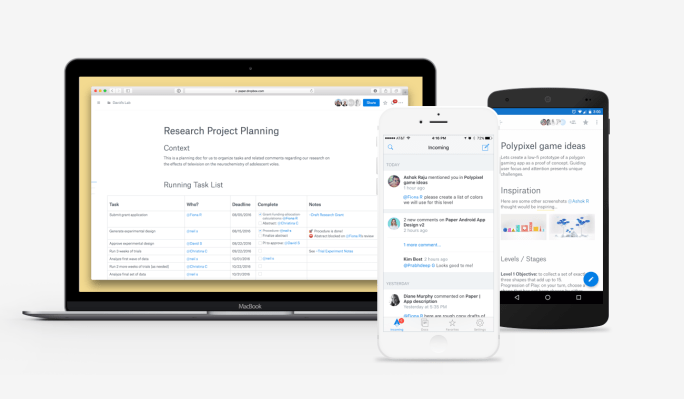It’s an interesting time for Dropbox’s document-building tool, Paper.
Quip, in a similar vein to Paper, was bought for a whopping $750 million by Salesforce earlier this week. This deal surprised a ton of people, but made a lot of sense given that Salesforce has seemingly been dipping its toes into collaboration software. So Quip is a great, and natural, fit for Salesforce and places it in further direct competition with products like Paper.
Dropbox is not only going up against Google Docs, but an increasingly slew of competitors in the collaboration space. Now, it’s hoping to figure out how to further branch its collaborative document-editing tool into the world with a few updates and a new mobile application that’s available today for Android and iOS. There are a bunch of updates to the Paper beta coming today for the Web as well, including enhanced tables, image galleries, and notifications across multiple devices.
“We’re very aware of our competitors, we actually see paper being pretty uniquely positioned,” Dropbox Group Product Manager Kavitha Radhakrishnan said. “We’re not just about creating documents, communicating and getting feedback, search. We’re a holistic team solution in terms of being used as a hub. This is what we’re seeing our early users do. A huge differentiator is we do provide solutions regardless of what tools the users are using today.”
It’s natural that tools for Paper to exist. Rather than trading around information, documents and embedded content like photos or tables it’s easier for them all to exist in one place where anyone can edit the documents. It’s part of the reason tools like Google Docs have become so popular and have seen so much investment.
Paper essentially exists as a document that’s supposed to naturally evolve with a few core types of embeds over time. Users can create checklists, embed tables and photo galleries, and of course comment throughout. These kinds of tools hit all the right pain points for companies that are looking to synchronize information across multiple teams and develop their plans and products over time.
The app isn’t just a slimmed down version of a document editor. Instead, it’s designed to be an extension of the things that happen in the Web document editing tool. Users will be able to see comments and reply to them, view their notifications and documents and make small changes on the go, among other tools. It’s not supposed to completely emulate the experience, which certainly wouldn’t work on a smaller screen.
Instead of feature creeping Paper right from the get-go, there was plenty that didn’t make it into Paper, Radhakrishnan said. Some interesting user behavior popped up in the process, like design firms using it to keep track over time of the changes they’d made to several designs. So there’s a lot of flexibility for a tool like this, Radhakrishnan said. There’s a potential opportunity to open up Paper to developers, but right now Dropbox wanted to stick to the basics, she said.
One thing Radhakrishnan stressed throughout the conversation was that the features that made it into Paper was a constant result of user testing. Such a data-driven approach is common in larger companies, and it’s not surprising that Dropbox would take such a rigorous approach to enterprise tools. Releasing new beta tools and applications gives Dropbox an increasing ability to figure out what new user behavior pops up that it can account for.
As Dropbox has continued to grow up, it’s had to evolve its strategy in order to compete with larger enterprise services. Over time, its core cloud storage product — designed to be dead simple in order to attract and keep ahold of its users — has slowly become commoditized by huge incumbents like Apple and Alphabet. There’s always the chance that Alphabet and Apple could pull the trigger on new features and pricing models that would capture a large swath of Dropbox’s paying customers.
So it’s had to find a new way to bring in paying customers, and a big part of that focus has been finding and attracting large enterprise clients. For example, Dropbox recently released a tool that would allow companies to literally scan and edit documents in the real world using advanced character recognition tools. New tools like that, and updates to Paper, are critical to not only attract new business customers but retain its 200,000 paying enterprise customers.
The competition is, of course, fierce. It’s going up against companies that have prioritized enterprise from the get-go like Box. It has to deal with the constant threat of companies like Microsoft with their Office 365 tools. Dropbox’s pitch has always been that it’s a much simpler product with a cleaner interface, but it has to make sure it gets all the right tools in its enterprise products to back up that pitch.
Its registered user base is quite large at 500 million registered users (though it’s not immediately clear how active that user base is). But times and ecosystems change, and new updates and tools like the Paper mobile application are ways to figure out how to figure out what Dropbox looks like within larger companies outside of just standard file storage and sharing.
“As the world today changes, more and more collaboration is happening online, but there is a lot of collaboration that happens on the file system,” Radhakrishnan said. “One is, we’re very simple user interface and that’s our link to Dropbox users — that as a philosophy we want to continue through Paper as well. We went through every feature we want to add a million times and make sure it works in the simplest way possible. That will continue, there’s no way that won’t happen.”
